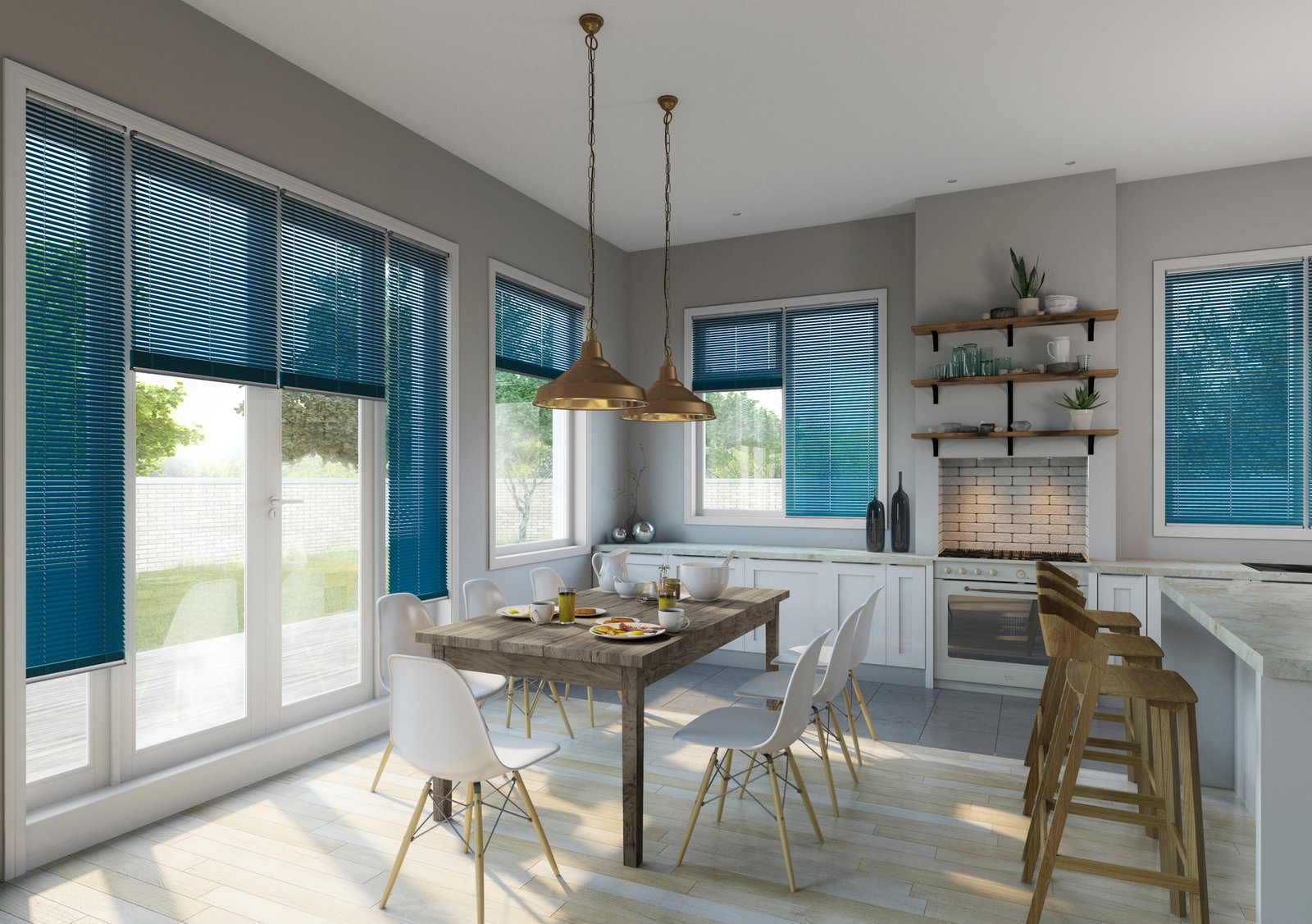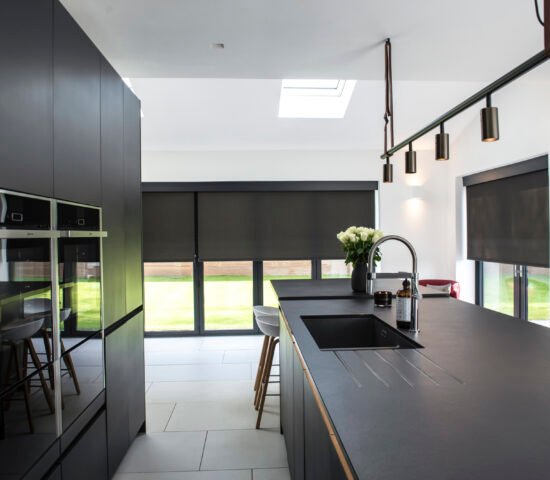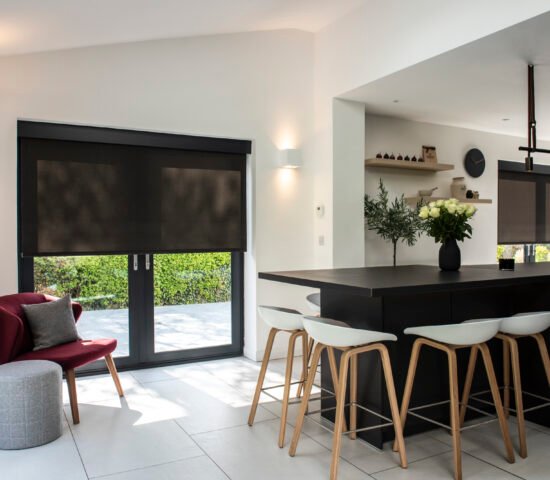
The Ultimate Buyer’s Guide to Window Blinds

Window blinds are an important part of your home’s internal space. They add a unique character and style to your home’s decor in addition to providing privacy and insulation.
But with so many types of window blinds on the market, it can be hard to decide which ones are right for your home.
In this article, we will explore the different types of window blinds on the market, and help you decide on buying blinds that are right for your home.
What are Window Blinds?
Window blinds are a kind of window treatment or window coverings that serve the dual purpose of aesthetics and practicality. In general, a window blind is made of several horizontal slats or vertical slats and is held together by cords.
Blinds can be categorised based on their style and material. Here is an exhaustive list of the different types of blinds that you may want to consider for your windows.
Roller blinds
In the UK, roller blind is probably the most popular type of blinds. They are usually installed in kitchen and bathroom windows. Roller blinds as the name suggests are fitted on a roller. And since they are made from one piece of fabric, they are not compatible with sloping windows. If you prefer darker indoors, roller blinds come in blackout fabrics.
Pros:
- Comparatively inexpensive
- Comes in a wide range of materials, colours and styles.
Cons:
- Not suitable for windows with irregular shapes
- They come with cords which may not be safe for children or pets in the house.
Venetian blinds
Venetian blinds are generally called aluminium blinds. They may also be made of real hardwood or faux wood. Venetian blinds come in multiple sizes and have a variety of styles. They are very easy to operate, and they do not require much maintenance. The top of the blinds has a headrail with a control mechanism. The control mechanism consists of tilting, raising, and lowering the slats.
Pros:
- A great alternative to window shutters
- Affordable price
- Greater light control
Cons:
- Does not block out light completely
- Taped Venetian blinds are not ideal for damp environments like kitchen or bathroom
Roman blinds
Roman blinds are made from thick fabric. Typically they are thicker than roller blinds fabric. What makes it different is the rods that are sewn inside to create uniform folds. These blinds don’t wrap around a roller.
Pros:
- An ideal choice for energy efficiency during winter months because of their thermal lining.
- A range of colour choice, designs, and patterns are available for its fabric.
Cons:
- Strings can be a hazard for pets and children
- Not a good option for rooms with moisture issues or humid environments
Vertical blinds
Vertical blinds are quite similar to Venetian blinds in terms of the way they function. The key difference is that vertical blinds are vertical and Venetian blinds are horizontal. The vanes are slid across the headrail with the help of two cords on the side. Vertical blinds generally have thinner fabric making it compatible with blackout or dimout functions.
Pros:
- Ideal for covering large areas
- Can be used for both indoor and outdoor applications
Cons:
- Cleaning and maintaining may be a hassle
Wooden blinds
These blinds are made of wooden slats. Wooden blinds are highly durable and long-lasting. They are ideal for bedrooms and living rooms. However, since wood is sensitive to the weather, humidity, and moisture, wooden slats may not be a good fit for humid places or rooms where moisture may be a concern.
Pros:
- Easy to clean
- Long-lasting
Cons:
- Susceptible to cracking, splitting, and warping
Faux Wood Blinds
Faux wood blinds are made of vinyl or plastic making them an affordable alternative to wood. Unlike wood, they are not sensitive to humidity or moisture making them ideal for bathrooms and kitchens.
Pros:
- Cheaper than wood blinds
- Easy to clean and maintain
Cons:
- Not as strong as wooden blinds
Pleated blinds
Pleated blinds are also called pleated shades. They are made of pleated fabric and can be rolled up from top to bottom to suit your needs. These blinds strike the right balance between privacy and light. Pleated blinds can also be fitted with another layer to turn them into blackout blinds. They are well suited for large or round windows. Cellular or honeycomb pattern is a popular style for pleated blinds.
Pros:
- Lightweight
- Easy to install
- Energy efficient
Cons:
- It may look tacky due to the pleating.
Cellular Blinds
Cellular blinds (also known as honeycomb blinds) are similar to pleated blinds and are made of similar materials.
Pros:
- Greater privacy
- Excellent sound insulation
- Lightweight, thin and stackable
Cons:
- Limited design styles
- Limited control over light entering your room
- Cleaning can be difficult because of its structure
Smart blinds
Smart blinds are like automatic blinds that can be controlled using an app or voice commands. Some types of advanced smart blinds offer functionalities such as the ability to automatically control the shades based on an exterior light.
Pros:
- Automatic adjustment to environmental conditions
- Highly customizable
Cons:
- Expensive
- Requires installation by professionals
Thermal blinds
Thermal blinds are designed to trap heat in the winters or keep your room cooler in the summer. Thermal blinds come in different shapes and sizes and are made of a special thermal range of fabrics.. They are basically another layer between your room and the windowpane for better insulation.
Pros:
- Keeps the room cool during summers
- Maintains temperature inside the room during winter months
Cons:
- Not suited for all the rooms
Sheer blinds
Sheer blinds are quite similar to silhouette shadings. They feature two sheer fabrics with alternating solid panels. They offer great privacy while also letting in abundant natural light. However, they also come in blackout options.
Pros:
- Allows a good amount of natural room into the room
- Elegant
Cons:
- Expensive
Cordless blinds
Cordless blinds are becoming increasingly popular in the UK because of their safety, privacy, and ease of use. If you have toddlers or pets at home, cordless blinds offer safety and peace of mind.
Pros:
- Safe for children and animals in the house because of the lack of cords
- Offers privacy and sufficient natural light
- Easy to operate
Cons:
- Not suitable for tall windows
- Cordless blinds with heavy fabric can be challenging to lift
Motorised blinds/electric blinds
Electric blinds are motor-driven and operated by remote control. Motorized blinds are more expensive but offer better functionality and convenience. Electric blinds are usually installed using screws or clips instead of brackets. They are also cordless which means they don’t pose a risk if you have children at home.
Pros:
- Convenient
- Functional
- Lots of design and style options
Cons:
- More expensive than standard blinds
- Motor failures may leave you with an open blind until a technician arrives
Blackout blinds
Blackout blinds are designed to block out any light coming through the window. This type of blind is often used in bedrooms and offices. Blackout blinds are available in various materials such as aluminium, steel, wood, and PVC.
Pros:
- Completely blocks out light for comfortable daytime sleep
- Great thermal insulation and temperature control
- Easy to operate
- Blocks out noise as well
Cons:
- Limited style options
- Blocks out natural night which may not be always a good thing
Made to measure blinds
These blinds are custom-made and tailored to fit your specific requirements. Made to Measure Blinds can be ordered online and delivered directly to your door. You will need to provide measurements of your window and the size of your blinds. One major benefit of made to measure blind is that it can be completely customised to fit the pattern or design that you want.
Pros:
- Custom-fit
- Can be fitted within a short period of time
Cons:
- Costlier than ready-to-use blinds
Day-night blinds
These blinds have a dual layer of overlapping fabric. One side is opaque while the other side is translucent. This allows both day and night lights to enter the room. Day-Night blinds are ideal for rooms where there is no need for complete darkness.
Pros:
- Excellent light control in the room
- Serves as an independent window decoration
Cons:
- Does provide an option to block out natural light completely
- Slow operation
- Needs more fabric than traditional blinds
- Costlier than traditional blinds
Outdoor blinds
Outdoor blinds are mostly used in outdoor areas such as patios, glass doors, balconies, terraces, gardens, verandahs, etc. They are used to block sunlight, rain or wind to a certain extent before they reach the interior of your house. Skylight blinds or conservatory blinds can also be used to serve the purpose. Outdoor Blinds are made from strong materials like canvas, polyester, cotton, etc.
Pros:
- Enhances the external aesthetics of your home
- Wide range of colour, material and design options
- Offers excellent light and privacy control
Cons:
- Expensive compared to regular blinds
- Requires maintenance
Mini blinds and Micro blinds
Mini blinds use slats that are smaller than the slats of standard blinds. They have wands and cords for easy operation. Micro blinds are even smaller versions of mini blinds.
Pros:
- Effective light filtering
- Not very expensive
- Easy to clean
Cons:
- Limited privacy at night
Panel Blinds
Panel blinds are slightly modified versions of vertical blinds. They have wide fabrics that can be smoothly operated on a headrail. They are ideal for patios, large windows and bi-fold doors.
You might be interested in: Blinds | Roller Blinds With Pelmet
Blinds Vs. Shades – What’s the difference?
How often have you wondered about the difference between blinds and shades? Blinds and Shades are two different types of window treatments that serve similar purposes. Both blinds and shades come in many styles and designs. The main difference lies in their function. Blinds are used to block out light whereas shades allow some amount of light into the room. Blinds are generally thicker than shades.
In terms of structure, blinds have slats that can be tilted up or down, while shades are solid fabrics that provide a softer covering.
You might be interested in: Energy saving benefits of roller blinds
Blinds vs Shades – Pros & Cons
Blinds are popular among homeowners because of their versatility. They can be used to block out light, keep heat inside during winter, and also provide privacy.
However, blinds do require constant care and maintenance. In addition, they cannot be opened or closed easily. Some blinds even require manual lifting and lowering.
Shades on the other hand are easy to operate. They are usually operated by remote controls. Most shades are equipped with automatic opening and closing mechanisms. Also, they are lighter than blinds.
Which one should you choose?
It depends on what kind of blinds you want. If you want something that blocks out light without any hassle, then go for blinds. On the other hand, if you prefer having access to daylight, then go for shades.
Benefits of Blinds
Blinds offer several benefits to homeowners. Here are some of the common type of blinds:
Privacy
Blinds help create a sense of privacy in your home. It helps reduce unwanted noise and disturbance from outside. This is especially useful when you live near busy roads or busy streets.
Energy Efficiency
Blinds are energy efficient and can help you bring down your energy costs. They help in conserving heat energy during winters and blocking out sunlight during summers.
Light Control
Blinds offer great light control. You can adjust the shade according to your needs. For example, you may use them to block out direct sunlight during the summer months. They also offer flexible adjustment for control over light that flows into the room.
Temperature Regulation
Blinds can regulate the temperature inside your home. During hot days, you can open the blinds to let more airflow in. During cold days, you can close the blinds to keep heat inside.
Safety
Blinds protect your children from falling objects. Children often play around windows and doors. By installing blinds, you can ensure that they stay safe.
Common Blinds Materials
Blinds come in a range of materials. Here are some common ones:
Cotton
Cotton is a natural fibre. It comes in various colours and textures. It is soft, absorbent, breathable, and comfortable. It is also hypoallergenic. It is highly recommended for allergy sufferers.
Polyester
Polyester is a synthetic fabric. It is often used to make clothes, blankets, carpets, curtains, etc. Polyester is lightweight and durable. It is stain-resistant and wrinkle-free. It is also easy to wash and dry.
Wood
Wood blinds have become increasingly popular over the years. They are available in different sizes, shapes, and finishes. They are typically made of wood veneers, plywood, particleboard, and MDF (Medium Density Fiberboard). These materials are strong, sturdy, and durable. They are ideal for homes with children and pets.
Faux Wood
Unlike real wood, faux wood does not cost a fortune yet provides an authentic look. Faux wood blinds come in many styles and designs. They are affordable and easy to install.
Plastic
Synthetic materials like plastic can also be used to make blinds. Plastic blinds are one of the most cost-effective blinds. Plastic materials also include vinyl.
Fabric
Natural fabric blinds come in many types, styles, and designs. They are available in all kinds of fabrics such as cotton, polyester, linen, silk, wool, jute, etc. Fabric blinds are affordable and easy to maintain. They are also suitable for homes with pets and kids.
Metal Blinds
Metal blinds are also a popular choice among homeowners in the UK. Metal blinds are available in different shades, patterns, and designs. They can be customised to fit any kind of window. They are very durable and long-lasting.
Aluminium
Aluminium blinds are very attractive. They come in various colours and patterns. They are also easy to install and maintain. Aluminium blinds are long-lasting and durable.
Steel
Steel blinds are heavy-duty. They are designed to withstand high winds and extreme weather conditions. They are also fireproof. They are ideal for areas where there is a lot of smoke and dust.
What is the best material for window blinds?
There are so many options out there. However, most people agree that aluminium is the best choice for blinds. Aluminium is lightweight and durable. Besides, it does not rust. However, one downside of aluminium is that it is an excellent conductor of heat and cold which makes it inefficient at preserving heat or cold energy.
If you are looking for a more energy-efficient option, then choose wooden blinds. Wood blinds are strong, sturdy, durable, and reliable.
Ready-made Blinds vs Made to measure blinds
In general, ready-made blinds are cheaper than made-to-measure blinds. But if you want customised blinds, then made-to-measure blinds will be better suited for you. This is because they are tailored to your specific needs. You can ask the manufacturer to make changes to the design or colour of the blinds. One downside of this made to measure blinds is that they are more expensive than ready-made blinds. However, the flexibility in design and colour choices are worth paying extra.
Blinds Cleaning and Maintenance
The cleaning process of blinds depends on their type and the material they are made of. For example, roller blinds require less maintenance compared to Venetian blinds.
In general, regular cleaning is required for all blinds. Make sure to clean them regularly. Use a soft cloth to wipe off dirt and grime. If necessary, use a vacuum cleaner to remove any loose particles.
How do I know when my blinds need replacing?
You should replace your blinds once the following happens:
1) The slats start falling apart
2) There are visible signs of wear and tear
3) Your blinds no longer fit properly
4) The slats have become frayed and look dirty and damaged.
Conclusion
So there you have it. We have discussed almost all types of window coverings and style of blinds along with their benefits and disadvantages. We hope that this will help you make an informed decision before buying blinds for living space.
If you need any further assistance, feel free to talk to one of our blinds and shutters experts!
Choosing the right blinds for your home
How do I know which type of blind is right for me?
If you are considering buying made to measure blinds, you should consider your personal requirements like style, aesthetics, practicality, budget and material.
Here are some questions you should ask yourself before you make a decision:
- What kind of light do you have in your room?
- Do you need better light control?
- Are there any specific features you’d like to incorporate into your blinds?
- How often do you change your curtains?
- Do you prefer a blackout blind or one that lets in natural light?
- Do you want blinds that open and close easily?
- Do you want your blinds to look good on both sides?
- Be sure to think about these questions before placing your order.
FAQs
What types of blinds are popular in 2022?
Some of the window blinds in vogue in 2022 are cordless blinds, smart blinds, cellular blinds and zebra blinds.
What are the best blinds for small windows?
Vertical blinds are considered to be ideal for small blinds. These types of blinds can be opened either side to side or split down the middle. They are made up of slats that run along a track at the top.
What are the cheapest types of blinds?
Among the most cost-effective or cheapest material types for blinds are aluminium blinds, faux wood blinds, vertical blinds and roller blinds.
What are zebra blinds?
Zebra blinds are a great alternative to horizontal blinds. They are either remotely operated or have a cord to adjust the light, insulation and privacy.



